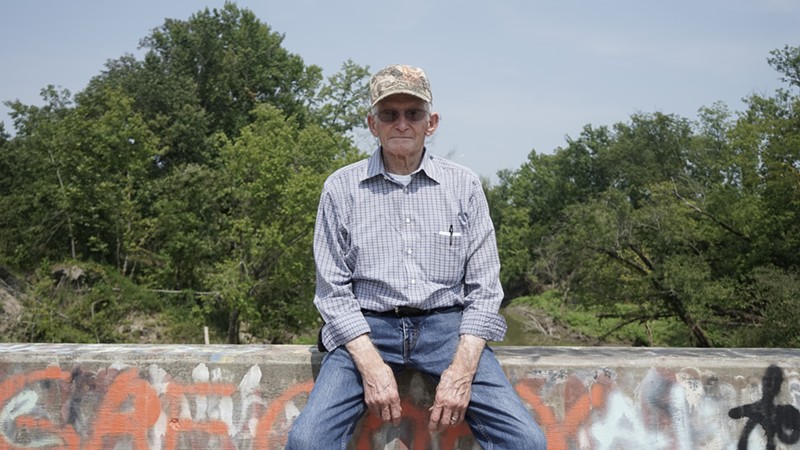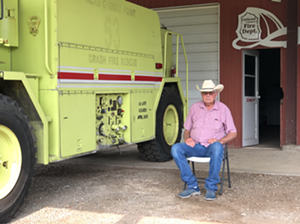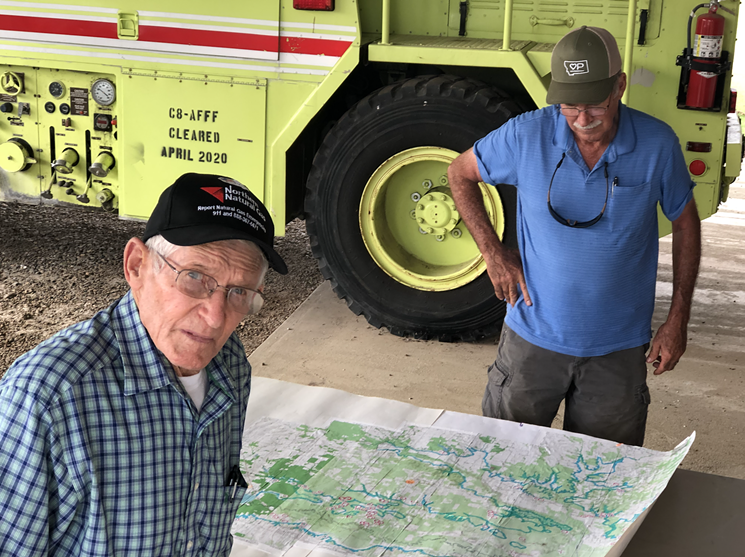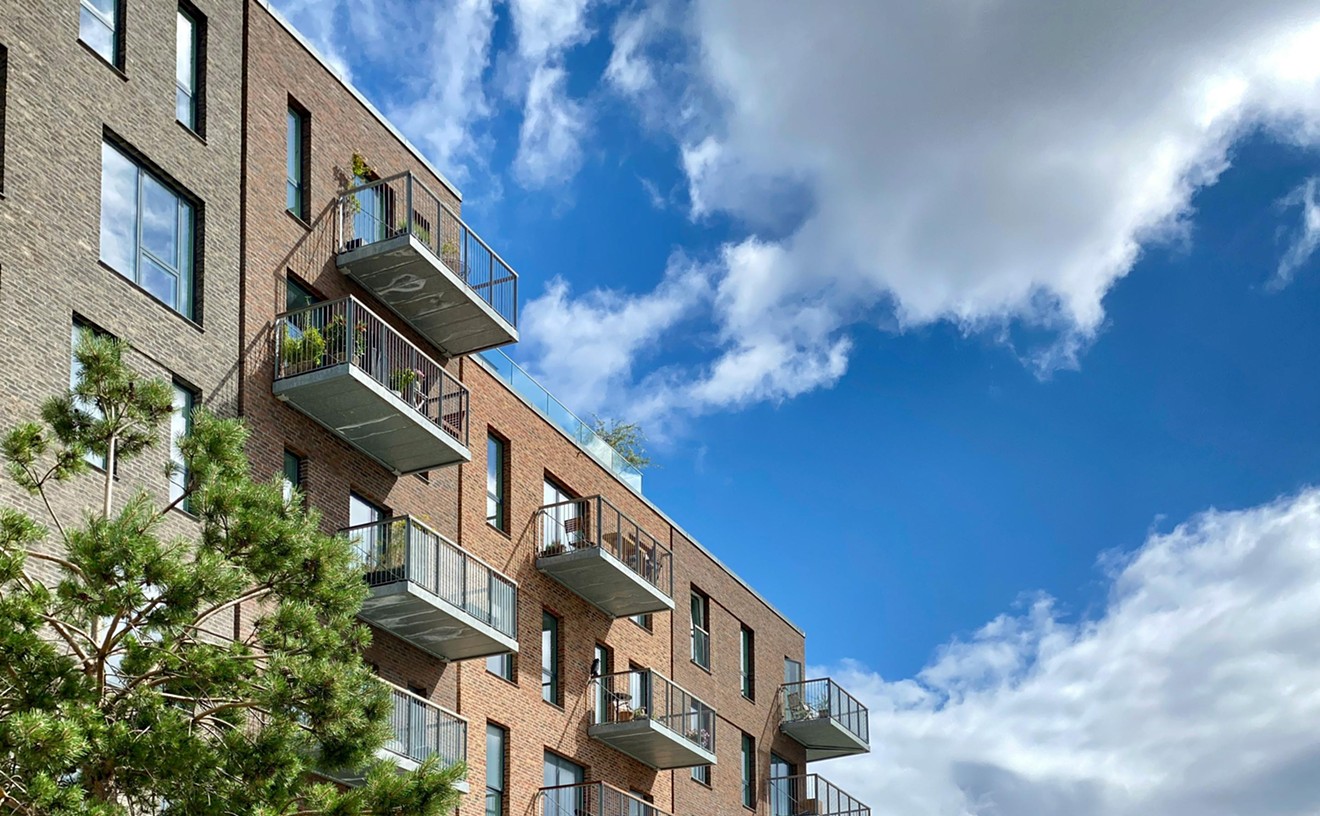If water planning officials in Dallas-Fort Worth get their way, Kennedy’s in-laws and everyone else buried at Cuthand Cemetery — some graves there date back to the Civil War — will one day wind up under water. Locals in Cuthand and other nearby communities say the Marvin Nichols Reservoir, which would help provide water to DFW’s swelling population, could strip them of their land, their livelihoods and their history.
“They say the cemetery, if they move it, they take a tombstone and a scoop of dirt and take it to another cemetery,” Kennedy explained. “All the bodies would still be there. There are a lot of people that their grandparents, great grandparents are buried out here, aunts, uncles, cousins.”
He and his wife often go to the cemetery to put flowers on her relatives’ graves and pay their respects. Her grandparents had also spent their lives in Cuthand. Kennedy said you can’t put a price on what they have out in Cuthand, but people keep trying to so that they can build the reservoir.
A stone’s throw south of the Red River, Cuthand sits some 130 miles northeast of Dallas, around two hours by car. Founded in the mid 19th century, the town’s population peaked in 1880 with around 130 residents. According to some reports, the community once had two cotton gins, a church, a school, a post office and at one point, some six practicing doctors. As the decades passed, the population thinned. The post office shuttered in the 1950s. Today, only a few dozen people still live there, but stop anywhere in town, and someone will give you an earful about the reservoir.
Kennedy first heard rumors about Marvin Nichols in the late 1980s, around the same time the volunteer fire station was established. (The station recently got a hand-me-down fire truck from another town. “We’re waiting on someone to come up here and show us how to operate it,” he said.)
At the time, affected communities were told it was a done deal, but Kennedy and others began meeting at the fire station to discuss how they could stop it. That’s how Cuthand’s fight against the reservoir began. More than three decades later, the reservoir still hasn’t been built, but Kennedy said the project weighs heavy on the townspeople’s shoulders nonetheless.
*
If Marvin Nichols happens, it will be situated at the main stem of Sulphur River, an area that sprawls across both Titus and Red River counties. From there, the water would travel southwest to Dallas-Fort Worth, a region where the population is expected to double to some 14.7 million by 2070. As more and more people flood North Texas, regional water officials are scrambling to meet water needs. The Marvin Nichols Reservoir, they think, could be the solution.
But the project comes at a hefty cost. It will clock in at $4.4 billion. On the land the reservoir will occupy, longtime residents will have to pack up and move elsewhere. Wildlife will be displaced. At least 65,000 acres of land will be destroyed, along with all of its resources. The local economies will be hammered. That’s why the reservoir’s opponents in Cuthand and communities like it say DFW ought to instead focus on conservation or get the water from somewhere else.
Still, local opposition hasn’t given North Texas officials much pause. In an email to the Observer, J. Kevin Ward, general manager of the Trinity River Authority and chair of the DFW regional planning group, said they decided to move forward with the reservoir “after all attempts by Region C to choose another option had failed.”
One proposed option, Ward said, was to raise operational levels of the Wright Patman Reservoir. However, the Army Corps of Engineers ruled out this option in part because of the environmental damage it would cause and because it would produce less water than Marvin Nichols. They also considered building a smaller version of Marvin Nichols, but Ward said it wouldn't produce enough water either.
After the Texas Water Development Board approved the state water plan on June 30, the reservoir took another step toward becoming a reality. But opponents in Cuthand and elsewhere insist the fight isn’t over.
*
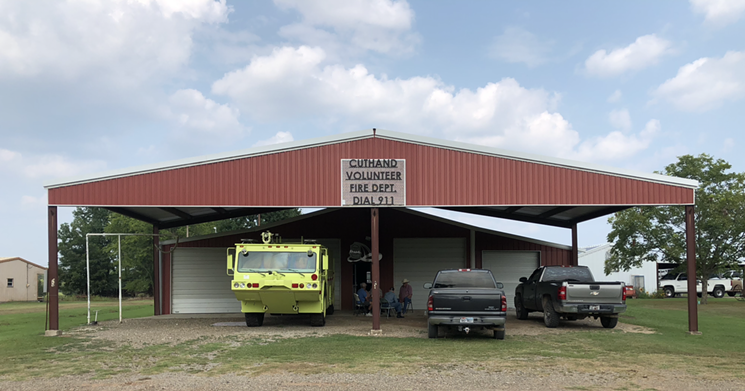
Cuthand's fight against the Marvin Nichols Reservoir began at their volunteer fire department.
Jacob Vaughn
Around Texas, 16 regional water boards meet periodically to prepare their water supply plans. DFW is Region C, and Northeast Texas counties fall in Region D. Those playbooks act as a template for Texas for the next 50 years.
Brooks, who grew up in Cuthand, lives some eight miles up the road from the fire station. “When I was a kid, everybody went to everybody’s house, especially on Sunday afternoons,” he said. “We’d go swimming, play ball, whatever. We’d go to school in Bogata.”
He remembers hearing about a potential reservoir project decades ago. “I heard they were going to build a big reservoir one of these days,” he recalled. “They never did say the name of it or anything like that.”
The ’50s brought three of the driest years Texas had ever seen: 1951, 1954 and 1956. At the time, the dry spells were believed to have constituted the most devastating droughts the state had experienced in some 600 years.
When the rain finally returned, the state started hunting for new ways to prevent similar dry spells from wreaking havoc on communities. That’s when the reservoir-building boom erupted. By 1970, the number of Texas reservoirs had doubled. By 1980, it topped 126.
In the '80s, the Texas Water Development Board did a survey of the state and mapped all the possible dam sites and reservoir sites. About 65,000 acres of land in Northeast Texas was marked for a potential reservoir.
Now Brooks owns land that will be affected by the Marvin Nichols Reservoir. On the Region D Water Board, members get two three-year terms, then have to sit out for a term before rejoining the board. Brooks was voted onto the board after he submitted an application. He had spent three decades working for the Texas-Mexico Power Co. in Bogata, and he said, “I really got into this Marvin Nichols thing after I retired.” Since then, he’s dedicated himself to fighting the reservoir.“Every five years, it’s the same thing. We’re fighting Marvin Nichols.” – John Brooks, Region D Water Development Board
tweet this
But the board does more than take on Marvin Nichols, Brooks said. “Water demand in our area and each community and town in our area, we look at that too and make preparations and arrangements for them to get their water as they need it,” he said.
Usually, there are two or three different options for getting more water. “Clarksville, for instance, they’re wanting to build a reservoir and have been for 20 years, I reckon. That was one of the options,” Brooks said. “Another option is for them to get water out of Lake Wright Patman piped to them, which is the cheapest option. We have to look at that kind of thing too.”
When it comes to the reservoir, though, “Every five years, it’s the same thing,” Brooks explained. “We’re fighting Marvin Nichols.”
One of the last meetings they held about Marvin Nichols was in Sulphur Springs a year and a half ago, not long before the coronavirus pandemic struck. “Region C was there and Region D people were there and people got up and spoke on it. But they just don’t want to listen or reason with us here,” Kennedy said.
The two regions had already agreed in 2016 that the reservoir would be off the table until at least 2070. But at the pre-pandemic meeting, Region C said it decided they wanted that pushed up to 2050. “I probably won’t be around to see it,” Kennedy said. “There’s going to be a lot younger people around to see it.”
If they want to start pumping water out of the reservoir by 2050, they’ll have to start buying land in the next 10 years — if they can get the required permits. More recently, Brooks said 63 people wrote to the Texas Water Development Board in opposition to the reservoir as the state approved its water plan over the summer. “Evidently they didn’t pay any attention,” he said. “They don’t care.”
I told him I’d only heard about the reservoir for the first time a few months ago on Facebook. “One thing about that, like you said you didn’t know nothing about it, there are hundreds of DFW area people that own 35-55 acre lots down here that don’t know anything about it,” Brooks said, explaining that many DFW residents travel to Cuthand to use the land for hunting and camping.
“One thing that is a concern is the unknown and one of the unknowns is the mitigation,” Brooks added. “How much mitigation land are we talking about?”
Under federal law, additional land — known as mitigation — is required to be set aside for wildlife disrupted by Marvin Nichols. Locals haven’t gotten an exact number, but they estimate another 130,000 acres will be taken for mitigation. So, the reservoir would remove nearly 200,000 acres from private land owners’ hands in Northeast Texas.
“We’ve got 66,000 acres under water, how much mitigation? Nobody would say because, I feel like, they feel like it’s going to upset a whole bunch more people when they start talking about how much it’s really going to take,” Brooks said. “It will be more. It will be more.”
He continued, “Where are all these people going to go who are losing their homes? What’s not in water will be in mitigation.” Brooks expects lawsuits at some point if Marvin Nichols keeps moving forward.
“They say we’re going to get paid well for our land. What is well?” Brooks asked. He said most of the land is appraised for about $3,000 an acre, and that’s without any improvements. “So, are we going to get $3,000, $3,500 an acre? Or are we going to get $600 an acre?”
His fears aren’t unfounded. That’s what happened with the Cooper Lake Reservoir on the South Sulphur River in Texas, about 75 miles east of DFW. “People got paid for their land up there, and some of them still owed money on the land after they got their payment,” Brooks said. “Them are horror stories that way, now.”
I wanted to know if there was any amount of money they’d give up their land for to build the reservoir. But Brooks explained that his entire life was tied to the region. “My daddy’s life was here. My granddaddy’s life, my great granddaddy’s life was here. My grandkids’, my kids’ lives are here.”
He paused. “If you look back, everybody at every reservoir’s always lost land,” he continued. “We’ve got to come up with something that can get people’s attention. Is it going to be the economics? Do we have to get environmental? What’s it going to take? Every five years we put all that out there, but nobody pays any attention.”
*
That’s about the time Gary Cheatwood, whom I’d made the trip to meet, pulled up to the fire station. He’s lived in Cuthand for most of his more than eight decades. A local lake bears his family name, he serves on the board of the Sulphur River Basin Authority, and he’s leading the fight against the reservoir.When it came to Marvin Nichols, he shares the same complaints and concerns that Brooks and Kennedy have. “This is what [the reservoir’s] going to do: It’s going to wipe us out,” Cheatwood said. “Every department member we got here has land or something that’s going to be taken away, or their livelihoods going to be gone or what have you.”
Cheatwood was born and raised in Cuthand. His roots there run deep. He offered to take me around the town to show me all they stood to lose to the reservoir.
We hopped in his work truck. The side mirrors were covered in cobwebs, some junk littered the interior, including a couple zip-lock bags of small caliber bullets. We drove down 1412. When Cheatwood was a kid, instead of gravel, 1412 used to just be a dirt road. When it rained, the road would turn into a runny mess of mud and clay that he and his brother would have to ride through on horseback.
We drove down the road, surrounded by tall trees and occasionally seeing groups of deer, as he told me about how this house was owned by so-and-so whose family’s been there for however many generations. There were others owned by people from California, Florida and the DFW area who moved to Cuthand not long ago. Cheatwood doubts the real estate agents told them about the reservoir before selling the land.
He took me to see part of his land, some of it with tall trees and thick foliage, completely untouched. This is how everything looked back when he was a kid, he said. He has around 70 different species of hardwood trees that include a giant Texas honey locust, which won a state championship for being the biggest of its species."It’s going to wipe us out." – Gary Cheatwood, Sulphur River Basin Authority
tweet this
He took me to his childhood home. His grandfather bought the land it’s on about a hundred years ago. The old box-shaped house was there when he bought it and it still stands today. His parents moved into the house in 1945 when Cheatwood was 5 years old, and he lived there until he went to college. It’s a little rundown, but it’s got good timber in it “and we need to salvage it," he said. It’s made of virgin short wood pine. If you look closely, you can see the ax marks from where people cut the wood all that time ago. Back then, they’d have to chop down the trees and have them hauled out with ox.
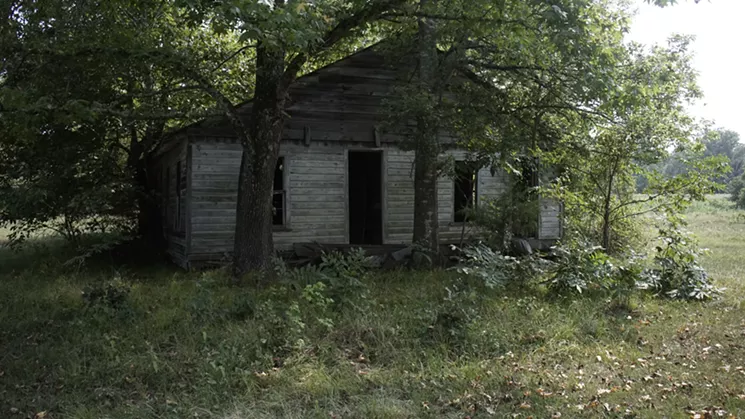
Gary Cheatwood moved into this house when he was 5 years old. It's been there ever since his grandfather bought the land about a hundred years ago.
Jacob Vaughn
Cheatwood said they must have rolled out of the cabinets when they started falling apart. On the porch was a well they used to get their water from. In the ’50s, their well dried up, so his dad picked a spot outside, dug through 23 feet of dirt, mud and clay until he struck water and built the family a new well.
He has a lot of good memories from living in that house. I asked if he ever gets sad seeing it succumb to nature and the years. He said he does, but he tries not to think about it too much. Thinking about how it could all be taken because of the reservoir is even harder.
People from Cuthand and other affected communities appeared in Pittsburg the next day for a Region D Water Board meeting to share similar stories. They also said DFW has other options, something they’ve been saying for years.
“Toledo Bend said they had all the water they could handle, but they don’t want to do that,” Kennedy said. “They want to build this lake.”
*
Janice Bezanson, Texas Conservation Alliance’s senior policy director, was also at the meeting. She’s at most of them. Bezanson has been in the fight against Marvin Nichols since the ’80s. Back then, she joined the Texas Conservation Alliance, and the damage caused by reservoir construction caught the organization’s attention.
Over the decades, Bezanson and her colleagues have learned that reservoirs can cause widespread harm not just to the environment, but also to a region’s social fabric and economy. Marvin Nichols would be no exception, she said. “We’re talking thousands of people who will be forced to sell their land,” she explained.
“There’s family cemeteries that will be inundated,” Bezanson added. “There are a huge number of archeological sites, many of them going back at least to the Clovis people, which is 12,000 years ago — the first very big wave of humans in North America — all that will be lost.”
According to Bezanson, DFW could meet its water needs without those consequences. Also a member of the Preserve Northeast Texas group, she said DFW planners should start by promoting conservation.
The Dallas area has a much higher per person water use than other parts of the state. “That makes it clear that the DFW area could continue to reduce,” she said.
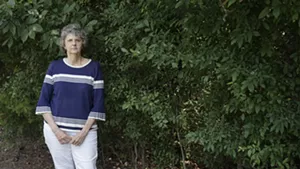
Janice Bezanson, Texas Conservation Alliance’s senior policy director, stands outside Region 8 center in Pittsburg, Texas.
Jacob Vaughn
She said the big-ticket possibilities have to do with lawn watering and moving to more native species of grass for lawns. People often fill their lawns with species that are not native and take up more water.
On top of that, Bezanson believes DFW could rely more on reservoirs that already exist, such as the supply in Lake Texoma. “Using any of the existing reservoirs that have already had the damage done is better than perpetrating it on a new set of people,” she said.
University of Texas at Dallas geoscientist Dr. Robert J. Stern said there are other options, but they vary in cost and feasibility. As it is, water from the Red River or Lake Texoma is too salty. “Nobody wants to drink that water absent desalination projects, which that’s certainly something to look into,” he said.
As for conservation, DFW could recycle some of its water. “All the toilets in the metroplex flush into the Trinity River,” he said. “We could put a dam south of town and treat that water and pump it back in. There’s no reason we can’t do that.” He said he thinks that might be cheaper than some desalination projects.
No matter how you look at it though, he said, we’re going to need more water. “As Dallas continues to grow, even without climate change, it’s going to be a challenge and we owe it to the future to think about what we’re going to do to prepare for growth and climate change,” he said. “We need to think very rationally about the future of this part of Texas.”“We need to think very rationally about the future of this part of Texas.” – Dr. Robert J. Stern, University of Texas at Dallas
tweet this
DFW has already felt growth and will continue to, "and that Sulphur River is very attractive to the reality of our city,” Stern said. “And it’s very unattractive, obviously, to the people that live there. But eminent domain being what it is, there’s times that you have to make people unhappy. That’s not my job to determine when that is, but I can see that we are going to need more water. That much I can see.”
Bezanson and the others expected the state's water plan to be approved, which only took some 10 minutes. Now, they’re preparing to fight the two permits needed to get the Marvin Nichols project done. “It would be very hard to get a project approved if it weren’t in the state water plan, but just being in the plan does not mean it’s going to be built,” Bezanson said. “Where the rubber hits the road is when the permits are applied for.”
One is a state water rights permit, which would authorize the storing of water in the reservoir to be diverted for specific uses. The other is called a 404 permit because it’s from Section 404 of the federal Clean Water Act and is administered by the U.S. Army Corps of Engineers. As part of this permit process, an environmental impact statement is created, which will outline all of the different ways the project will affect the proposed site.
“The real fights will be when those two permits are in process,” Bezanson said. “If they are granted, there will likely be lawsuits.”
After required studies for the project are conducted, the Texas Commission on Environmental Quality will put out a draft version of the state water rights permit for the public to review. During that time, anyone can comment on the permit, but those who are directly affected can request a hearing to contest the permit. “There is absolutely no question that there will be massive requests for contested case hearings when they get to the point of having a draft permit on this project,” she said.
So, the fight continues. It’s one that residents in Cuthand have had to instill in their kids because they’re not sure if they’ll be around long enough to see it to the end.
Cheatwood drove his truck to a small, graffiti-covered bridge that passes over the Sulphur River. They call it graffiti alley. He said, “This is the mighty Sulphur everybody’s fighting over.”
At 82 years old, the only time Cheatwood spent away from Cuthand was about a decade when he was in the Army, attending college and working out of state. That time away taught him his town was unique. “I don’t know of any other place I want to go,” he said “I’ve lived in over four or five different states in the 10 years I was gone. I never found any place like this.”

